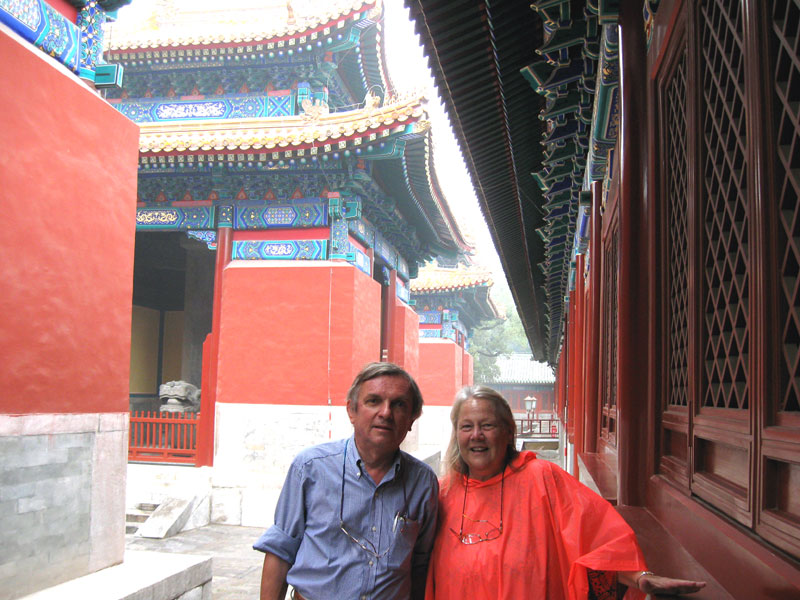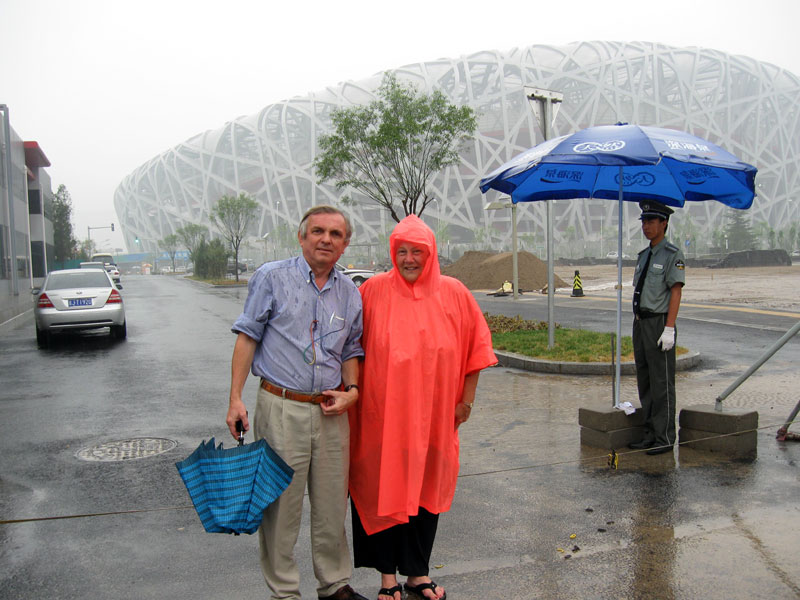
On our last day in Beijing, it was raining and we took a taxi for the whole day to take us to a lot of places. First: The "birds' nest", Swiss-designed 2008 Olympic stadium. The sky over Beijing was this colour always, whether it rained or not. Click for an even larger image.
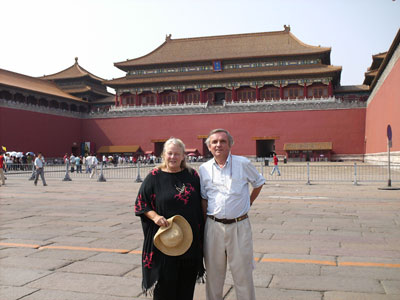
This was our first day in Beijing, arriving from Korea. Our hotel was close to the Forbidden City ... on the way here here, we found a great local restaurant in a hotel for Chinese tourists and, although only a few blocks' walk, we were offered lots of things to buy, especially by fake "students of calligraphy". Click to see a large image.
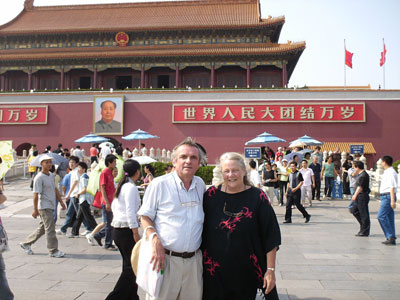
Tomas, Barbara and Mao in front of the Forbidden City in Tiananmen Square. Lots of soldiers all around. Our first few days here were fairly clear though the sun never quite made it through the haze. Lots of red flags everywhere and armies of Chinese tourists. Click for a large image.
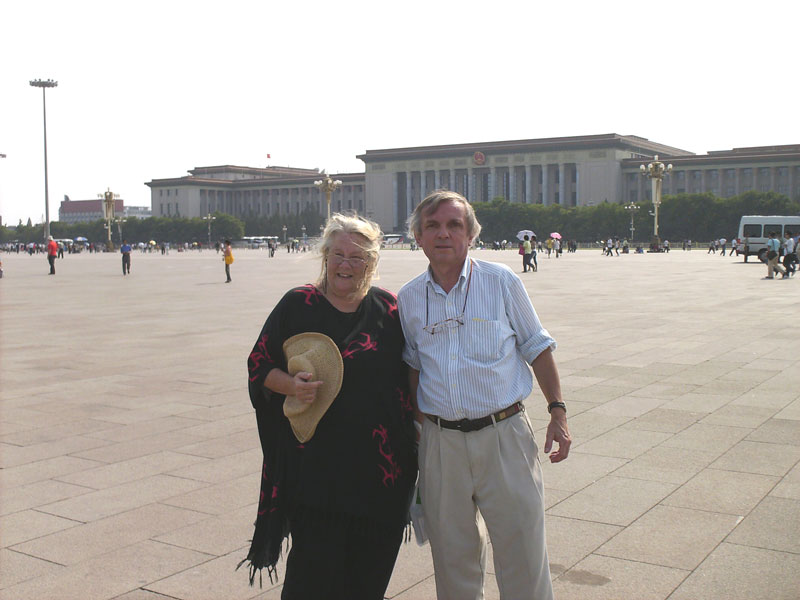
The guide books said that Tiananmen Square was the largest square in the world. They may well be right. The Communist Great Hall of the People is a vast auditorium and has banqueting halls and, once in a while, hosts a session of the National People's Congress, but that's not very often. Click for an even larger image.

Tiananmen Square is surrounded by big roads with a lot of traffic and fences that prevent access across them, so there are only a few access points, by underground passages and a few crossings and at each entry there are several soldiers and airport-like security stations ready to search anyone looking suspicious. Mao looks on from the distance. Click to see a large image.
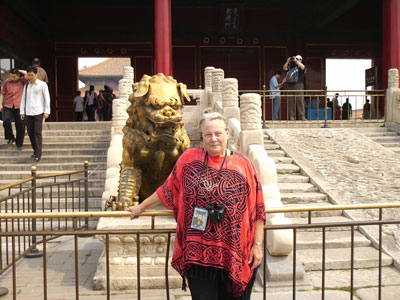
The 250 tonne marble carving in front of the Hall of Preserving Harmony, in the Forbidden City has carvings of dragons and clouds was moved into Beijing on a path covered with ice in the winter. The emperor was conveyed over this in his sedan chair as he ascended and descended the throne inside. Click for a large image.
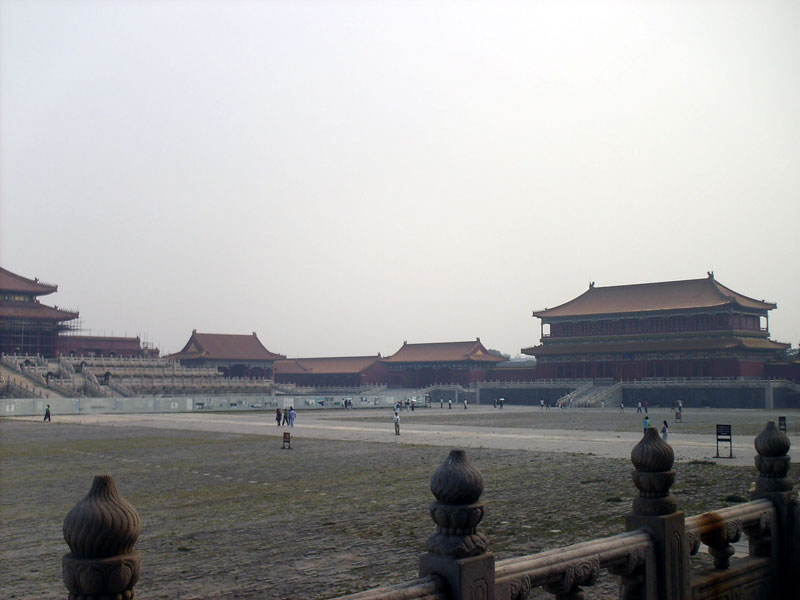
Looking into the main square of the Forbidden City, from the Gate of Supreme Harmony to the Hall of Middle Harmony (on the left, with scaffolding). The palace was finished in 1420. This courtyard could hold 100,000 people for royal ceremonies. The sky over Beijing was always this colour! Click on it for a larger image.
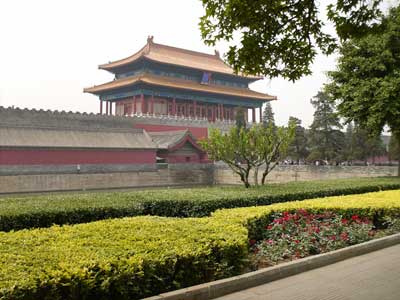
Walls of the Forbidden City are surrounded by a moat and a park. In the 14th century, they built a park and a temple on a hill made out all the earth excavated out of the moat. The Forbidden City visit makes for a lot of walking. Their audio guide is the best we've seen anywhere ... it senses automatically where you are in the palace and starts to talk, while the machine itself has a map on it, where a little blinking light indicates where you are. Click to see a large image.
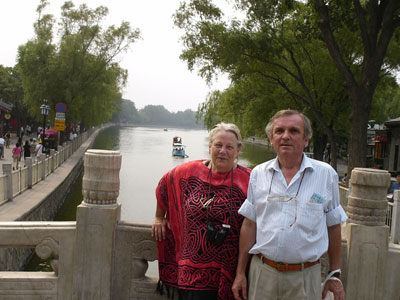
After a long visit to see the huge palace, time for lunch at Qian Hai, a lake just north of the Forbidden City, with pleasure boats, surrounded by dozens of nice restaurants. We also took a rickshaw trip of the surrounding "hutong", the old, cramped housing area with tiny houses and crooked alleyways ... old China inside and modern restaurants just outside are very close to each other. Click for a large image.
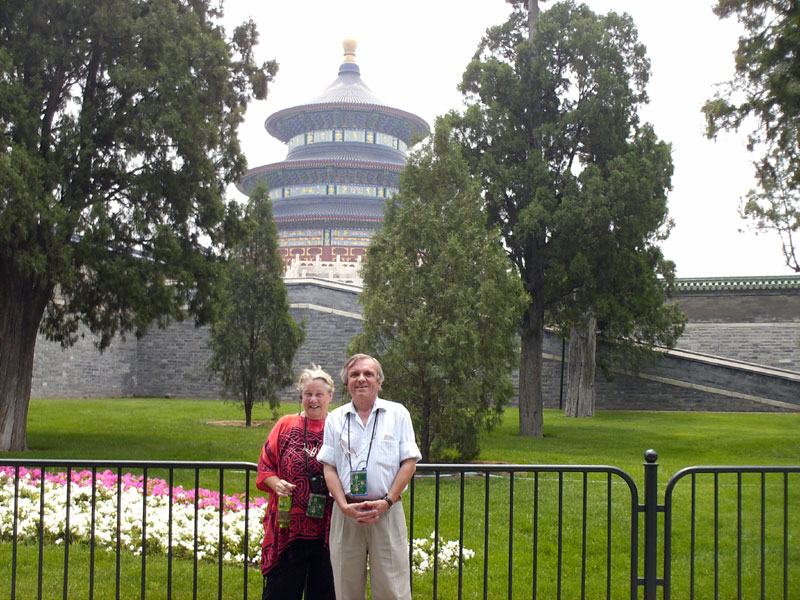
Here we are in the enormous gardens of the Temple of Heaven in Beijing! People sit, dance, play single-string violins or sing in large groups and enjoy the park. And the huge temple is the biggest in China! Click to see a larger image.
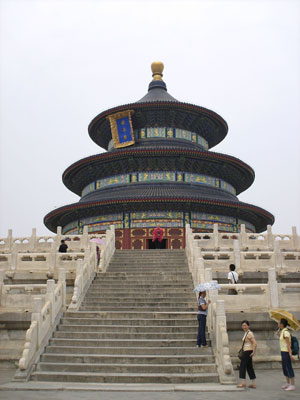
Tian Tan, completed in the Ming dynasty, The Temple of Heaven seems to be the symbol of old China as the Olympic Stadium is going to be the new. Barbara stands on top of the steps. Click to see a large image.

This temple was off limits to commoners during the Ming and Qing dynasties. It is located in a huge park, where people now practice tai ji. Built in 1420, it was destroyed by a lighting bolt in 1889 and rebuilt the following year. Click for a large image.
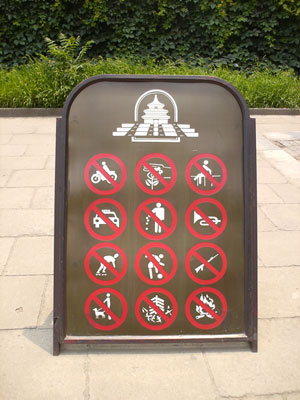
No motorbikes, no roller skates, no cars, no ball games, no dogs, no picking flowers, no fires, no loud music, so tai ji and group dancing are among the few things people can do in this enormous park in the center if Beijing, while traditional Chinese muzak is oozing out of all the lamps that have built-in speakers. Click to see a large image.
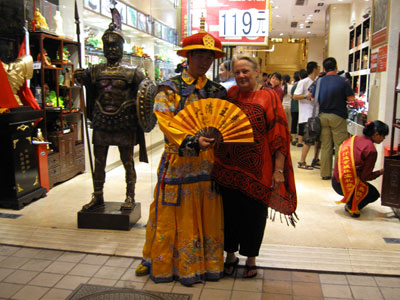
Our hotel was on Wanfujing Street, a sort of Beijing Oxford Street with department stores old and new, and open till late at night, with food, clothing, cameras, memory sticks. Barbara checks out a shop with Chinese clothes and chopsticks. Click for a large image.
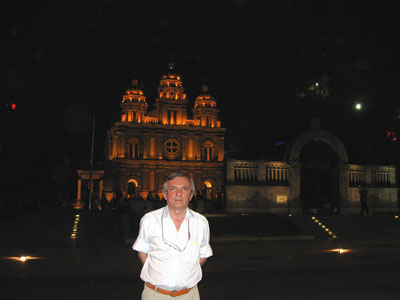
Between our hotel and the shops, on Wanfujing, and across from where you haggle over digital cameras, is St.Joseph's Church, built in 1655 but destroyed by several earthquakes, fires and rebellions ... now restored. Click to see a large image.
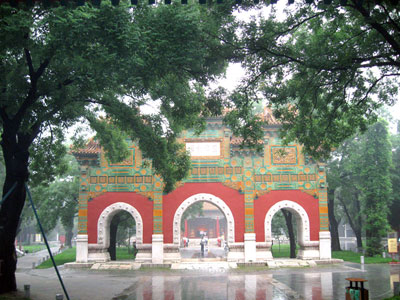
In the grounds of the Confucius Temple stands this ancient university, where civil servants studied and took their exams. As we got in and read our guide book, a dozen Chinese photographers took many photos of us ... by now, we must be on lots of Chinese websites as the gringos studying Confucianism. Click for a large image.
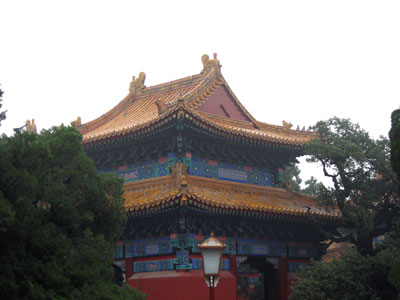
As we got in and read our guide book, a dozen Chinese photographers took many photos of us ... by now, we must be on lots of Chinese websites as the gringo couple studying Confucianism. Click to see a large image.

In the grounds of the Confucius Temple stands this ancient university, where civil servants studied and took their exams. Click for a large image.
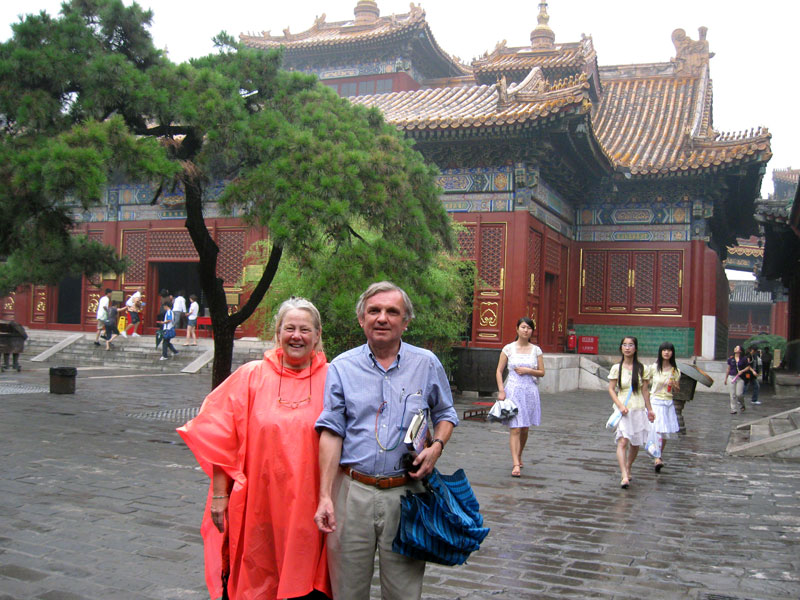
After the Confuciius Temple, our taxi took us to this large Lama Temple. Originally a 17th century palace for a royal prince, in 1744 it was converted into a Tibetan "lamasery". It has five main halls with buddhas. It survived destruction during the Cultural Revolution, because Zhou Enlai himself took an interest in its preservation. Click to see a large image.

The Lama Temple has beautiful Chinese buildings and, in this one, a vast 55 ft (17m) high statue of Buddha, but you aren't allowed to take photos. Click to see a large image.
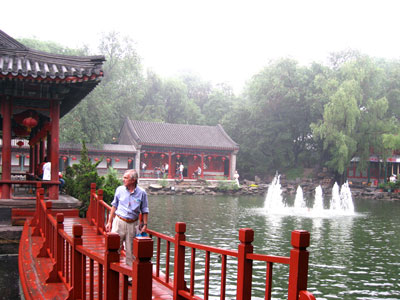
Before lunch, our taxi took us to another interesting place, Mansion of Prince Gong. Originally built 1777-1787, the owner was soon executed for using "royal motifs" in the designs, the house confiscated and in the mid-10th century used by a Prince Gong. Click for a large image.
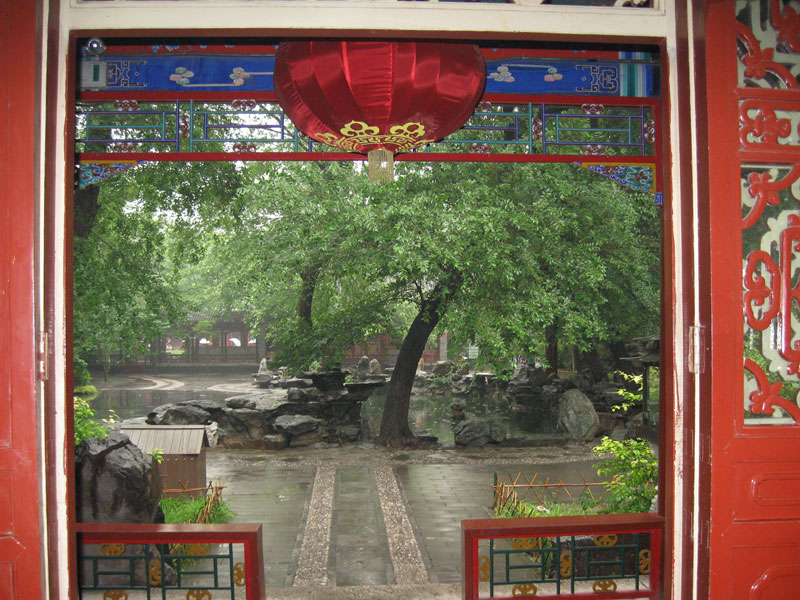
Inside Prince Gong's Mansion and gardens. It's Beijing's most complete example of a historic mansion, in the heart of an old "hutong" district near Qian Hai, where we had a nice lunch. Click to see a large image.
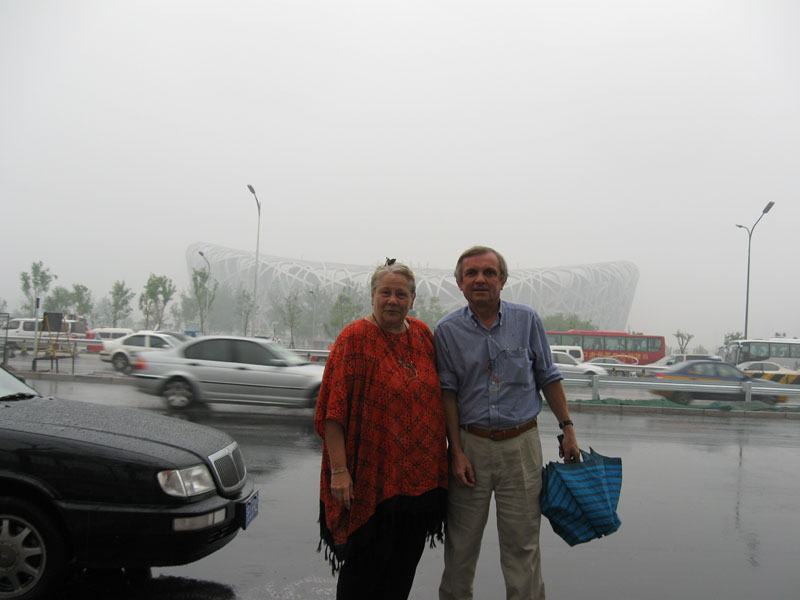
We asked the taxi to stop to take a photo, in the rain, of the Bird's Nest, the 2008 Olympic stadium, seen across a busy highway. For the Olympics, Beijing eliminates half the cars to make traffic flow better and improve the air quality, but after the Games, this colour sky will be the daily norm again. And here we said good-bye to Beijing and set out on a trip around China, which you can see in our other pages. Click to see a large image.
Click here to see photos from Seoul, South Korea, Daegu and Gyeongju, South Korea, The Great Wall, X'ian,Chongqing, Fengdu "City of Ghosts" , Yangtze River and the "Lesser Three Gorges", the Three Gorges Dam, Wuhan, Shanghai, Suzhou, or go back to Barbara's narrative of the trip
